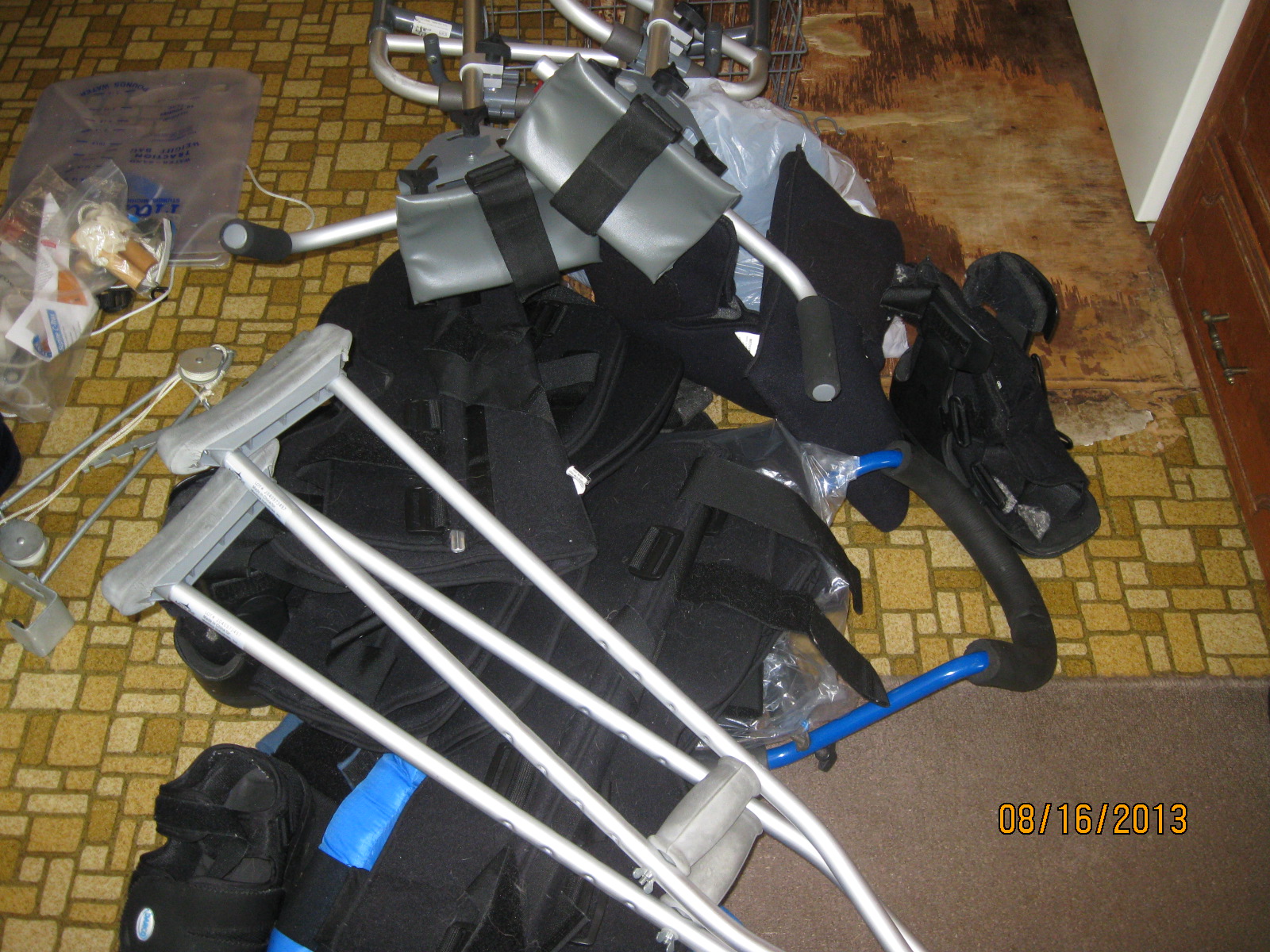This Levaquin crap ruined Karen's future!
Levofloxacin (Levaquin), Ciprofloxacin (Cipro), Moxifloxacin (Avelox), Norfloxacin (Noroxin), Ofloxacin (Floxin), Gemifloxacin (Factive) and Finafloxacin (Xtoro) should be taken off the market, and the FDA knows it! Levaquin made it so she could not walk from the tendinitis that it caused.
It is my conjecture that this class of antibiotics are damaging the spinal Dura, what contains the spinal fluid, so that the treatments for her CSF Leaks did not work. There is ZERO study on this FQ drug/Dura connection.
I will be at the first ever Intracranial Hypotension Symposium this fall to discuss this with the worlds leading CSF Leak doctors.
Based on my conjecture and input Lisa Bloomquist Palmer of Floxie Hope did her own homework and wrote: Do Fluoroquinolones Cause Cerebrospinal Fluid Leaks?
Karen's medical records
Karen's medical records from 2003 when she was given Levaquin. I'm posting them in the hopes they will help someone.
Karen spent a year crawling because of Levaquin
Karen spent a year crawling around the house on this construction, skate board like thing so her ankles would heal:
 All of this crap is the result of these #)$*#)$*# drugs!:
All of this crap is the result of these #)$*#)$*# drugs!:
The Karen Paddock Story at Pain Nation with Ken McKim
The condensed version of Karen's life of pain. Antibiotic issue is covered in the last ten minutes.
My TV Interview
http://www.newsnet5.com/news/local-news/investigations/levaquin-fda-fails-to-disclose-additional-serious-side-effects-of-antibiotic-linked-to-deaths is my Cleveland/Akron TV interview. 3,000 dead. 200,000 injured by these drugs per the FDA. That is estimated to be only one-percent of the real numbers!
The News Net5 FDA Report.
Try this link if the video does not play at the above link then try this locally served file, as IT at News Net5 keeps breaking the link:
FDA warns about increased risk of ruptures or tears in the aorta blood vessel
FDA warns about increased risk of ruptures or tears in the aorta blood vessel with fluoroquinolone antibiotics in certain patients
Safety Announcement [12-20-2018] A U.S. Food and Drug Administration (FDA) review found that fluoroquinolone antibiotics can increase the occurrence of rare but serious events of ruptures or tears in the main artery of the body, called the aorta. These tears, called aortic dissections, or ruptures of an aortic aneurysm can lead to dangerous bleeding or even death. They can occur with fluoroquinolones for systemic use given by mouth or through an injection.
Fluoroquinolones should not be used in patients at increased risk unless there are no other treatment options available. People at increased risk include those with a history of blockages or aneurysms (abnormal bulges) of the aorta or other blood vessels, high blood pressure, certain genetic disorders that involve blood vessel changes, and the elderly. We are requiring that a new warning about this risk be added to the prescribing information and patient Medication Guide for all fluoroquinolones.
Fluoroquinolone antibiotics are approved to treat certain bacterial infections and have been used for more than 30 years. They work by killing or stopping the growth of bacteria that can cause illness. Without treatment, some infections can spread and lead to serious health problems (see List of Currently Available FDA-Approved Systemic Fluoroquinolones).
Health care professionals should avoid prescribing fluoroquinolone antibiotics to patients who have an aortic aneurysm or are at risk for an aortic aneurysm, such as patients with peripheral atherosclerotic vascular diseases, hypertension, certain genetic conditions such as Marfan syndrome and Ehlers-Danlos syndrome, and elderly patients. Prescribe fluoroquinolones to these patients only when no other treatment options are available. Advise all patients to seek immediate medical treatment for any symptoms associated with aortic aneurysm. Stop fluoroquinolone treatment immediately if a patient reports side effects suggestive of aortic aneurysm or dissection.
Patients should seek medical attention immediately by going to an emergency room or calling 911 if you experience sudden, severe, and constant pain in the stomach, chest or back. Be aware that symptoms of an aortic aneurysm often do not show up until the aneurysm becomes large or bursts, so report any unusual side effects from taking fluoroquinolones to your health care professional immediately. Before starting an antibiotic prescription, inform your health care professional if you have a history of aneurysms, blockages or hardening of the arteries, high blood pressure, or genetic conditions such as Marfan syndrome or Ehlers-Danlos syndrome. If you have been prescribed a fluoroquinolone to treat an infection, do not stop the antibiotic without first talking to your health care professional.
We reviewed cases reported to FDA* and four published observational studies1,2,3,4 that showed an increased risk of aortic aneurysm or dissection associated with fluoroquinolone use (see Data Summary). How some of the studies were designed or carried out, and the ways the data were analyzed could affect the study findings; however, taken together, the results of all four studies provide consistent evidence of an association between fluoroquinolone use and aortic aneurysm or dissection. The underlying mechanism for this risk cannot be determined from these studies, and the background risk of aortic aneurysm can vary depending on the population. The background risk has been estimated from nine aortic aneurysm events per 100,000 people per year in the general population to 300 aortic aneurysm events per 100,000 people per year in individuals at highest risk. Because multiple studies showed higher rates of about twice the risk of aortic aneurysm rupture and dissection in those taking fluoroquinolones, FDA determined the warnings were warranted to alert health care professionals and patients.
We communicated safety information associated with fluoroquinolones in July 2018 (significant decreases in blood sugar and certain mental health side effects), July 2016 (disabling side effects of the tendons, muscles, joints, nerves, and central nervous system), May 2016 (restricting use for certain uncomplicated infections), August 2013External Link Disclaimer (peripheral neuropathy), and July 2008External Link Disclaimer (tendinitis and tendon rupture).
To help FDA track safety issues with medicines, we urge patients and health care professionals to report side effects involving fluoroquinolones or other medicines to the FDA MedWatch program, using the information in the “Contact FDA” box at the bottom of the page.
*The cases were reported to the FDA Adverse Event Reporting System (FAERS). [Which gets only 1% of actual reports!]
### Release: The U.S. Food and Drug Admini ### —- https://www.fda.gov/drugs/drug-safety-and-availability/fda-warns-about-increased-risk-ruptures-or-tears-aorta-blood-vessel-fluoroquinolone-antibiotics
FDA updates warnings [AGAIN!] for fluoroquinolone antibiotics on risks of mental health and low blood sugar adverse reactions
For Immediate Release July 10,2018
Release: The U.S. Food and Drug Administration today is requiring safety labeling changes for a class of antibiotics called fluoroquinolones to strengthen the warnings about the risks of mental health side effects and serious blood sugar disturbances, and make these warnings more consistent across the labeling for all fluoroquinolones taken by mouth or given by injection.
“The use of fluoroquinolones has a place in the treatment of serious bacterial infections — such as certain types of bacterial pneumonia — where the benefits of these drugs outweigh the risks, and they should remain available as a therapeutic option. The FDA remains committed to keeping the risk information about these products current and comprehensive to ensure that health care providers and patients consider the risks and benefits of fluoroquinolones and make an informed decision about their use,” said Edward Cox, M.D., director of the Office of Antimicrobial Products in the FDA’s Center for Drug Evaluation and Research.
FDA-approved fluoroquinolones include levofloxacin (Levaquin), ciprofloxacin (Cipro), ciprofloxacin extended-release tablets, moxifloxacin (Avelox), ofloxacin, gemifloxacin (Factive) and delafloxacin (Baxdela). There are more than 60 generic versions. The safety labeling changes the FDA is requiring today were based on a comprehensive review of the FDA’s adverse event reports and case reports published in medical literature.
Across the fluoroquinolone antibiotic class, a range of mental health side effects are already described in the Warnings and Precautions section of the drug labeling, but differed by individual drug. The new class-wide labeling changes will require that the mental health side effects be listed separately from other central nervous system side effects and be consistent across the labeling of the fluoroquinolone class. The mental health side effects to be included in the labeling across all the fluoroquinolones are disturbances in attention, disorientation, agitation, nervousness, memory impairment and delirium.
Additionally, the recent FDA review found instances of hypoglycemic coma where users of fluoroquinolones experienced hypoglycemia. As a result, the Blood Glucose Disturbances subsection of the labeling for all systemic fluoroquinolones will now be required to explicitly reflect the potential risk of coma with hypoglycemia.
Today, the FDA also published a drug safety communication about safety information regarding hypoglycemic coma and mental health side effects with fluoroquinolones.
The FDA first added a Boxed Warning to fluoroquinolones in July 2008 for the increased risk of tendinitis and tendon rupture. In February 2011, the risk of worsening symptoms for those with myasthenia gravis was added to the Boxed Warning. In August 2013, the agency required updates to the labeling to describe the potential for irreversible peripheral neuropathy (serious nerve damage).
In 2016, the FDA enhanced warnings about the association of fluoroquinolones with disabling and potentially permanent side effects involving tendons, muscles, joints, nerves and the central nervous system. Because the risk of these serious side effects generally outweighs the benefits for patients with acute bacterial sinusitis, acute bacterial exacerbation of chronic bronchitis and uncomplicated urinary tract infections, the FDA determined that fluoroquinolones should be reserved for use in patients with these conditions who have no alternative treatment options.
The patient Medication Guide that is required to be given to the patient with each fluoroquinolone prescription describes the safety issues associated with these medicines.
The FDA, an agency within the U.S. Department of Health and Human Services, protects the public health by assuring the safety, effectiveness, security of human and veterinary drugs, vaccines and other biological products for human use, and medical devices. The agency is also responsible for the safety and security of our nation’s food supply, cosmetics, dietary supplements, products that give off electronic radiation, and for regulating tobacco products.
security of human and veterinary drugs, vaccines and other biological products for human use, and medical devices. The agency is also responsible for the safety and security of our nation’s food supply, cosmetics, dietary supplements, products that give off electronic radiation, and for regulating tobacco products.
### Release: The U.S. Food and Drug Admini ### – https://www.fda.gov/newsevents/newsroom/pressannouncements/ucm612995.htm </blockquote>
FDA updates warnings for fluoroquinolone antibiotics Limits use for acute bacterial sinusitis, acute bacterial exacerbation of chronic bronchitis and uncomplicated urinary tract infections
For Immediate Release July 26, 2016
Release: The U.S. Food and Drug Administration today approved safety labeling changes for a class of antibiotics, called fluoroquinolones, to enhance warnings about their association with disabling and potentially permanent side effects and to limit their use in patients with less serious bacterial infections.
“Fluoroquinolones have risks and benefits that should be considered very carefully,” said Edward Cox, M.D., director of the Office of Antimicrobial Products in the FDA’s Center for Drug Evaluation and Research. “It’s important that both health care providers and patients are aware of both the risks and benefits of fluoroquinolones and make an informed decision about their use.”
Fluoroquinolones are antibiotics that kill or stop the growth of bacteria. While these drugs are effective in treating serious bacterial infections, an FDA safety review found that both oral and injectable fluroquinolones are associated with disabling side effects involving tendons, muscles, joints, nerves and the central nervous system. These side effects can occur hours to weeks after exposure to fluoroquinolones and may potentially be permanent.
Because the risk of these serious side effects generally outweighs the benefits for patients with acute bacterial sinusitis, acute exacerbation of chronic bronchitis and uncomplicated urinary tract infections, the FDA has determined that fluoroquinolones should be reserved for use in patients with these conditions who have no alternative treatment options. For some serious bacterial infections, including anthrax, plague and bacterial pneumonia among others, the benefits of fluoroquinolones outweigh the risks and it is appropriate for them to remain available as a therapeutic option.
FDA-approved fluoroquinolones include levofloxacin (Levaquin), ciprofloxacin (Cipro), ciprofloxacin extended-release tablets, moxifloxacin (Avelox), ofloxacin and gemifloxacin (Factive). The labeling changes include an updated Boxed Warning and revisions to the Warnings and Precautions section of the label about the risk of disabling and potentially irreversible adverse reactions that can occur together. The label also contains new limitation-of-use statements to reserve fluoroquinolones for patients who do not have other available treatment options for acute bacterial sinusitis, acute bacterial exacerbation of chronic bronchitis and uncomplicated urinary tract infections. The patient Medication Guide that is required to be given to the patient with each fluoroquinolone prescription describes the safety issues associated with these medicines.
The FDA first added a Boxed Warning to fluoroquinolones in July 2008 for the increased risk of tendinitis and tendon rupture. In February 2011, the risk of worsening symptoms for those with myasthenia gravis was added to the Boxed Warning. In August 2013, the agency required updates to the labels to describe the potential for irreversible peripheral neuropathy (serious nerve damage).
In November 2015, an FDA Advisory Committee discussed the risks and benefits of fluoroquinolones for the treatment of acute bacterial sinusitis, acute bacterial exacerbation of chronic bronchitis and uncomplicated urinary tract infections based on new safety information. The new information focused on two or more side effects occurring at the same time and causing the potential for irreversible impairment. The advisory committee concluded that the serious risks associated with the use of fluoroquinolones for these types of uncomplicated infections generally outweighed the benefits for patients with other treatment options.
Today’s action also follows a May 12, 2016, drug safety communication advising that fluoroquinolones should be reserved for these conditions only when there are no other options available due to potentially permanent, disabling side effects occurring together. The drug safety communication also announced the required labeling updates to reflect this new safety information.
The FDA, an agency within the U.S. Department of Health and Human Services, protects the public health by assuring the safety, effectiveness, security of human and veterinary drugs, vaccines and other biological products for human use, and medical devices. The agency is also responsible for the safety and security of our nation’s food supply, cosmetics, dietary supplements, products that give off electronic radiation, and for regulating tobacco products.
### – http://www.fda.gov/NewsEvents/Newsroom/PressAnnouncements/ucm513183.htm
European Medicines Agency’s (EMA) Pharmacovigilance Risk Assessment Committee (PRAC) has recommended restricting the use of fluoroquinolone and quinolone antibiotics
November 16 2018:
…Importantly, fluoroquinolones should generally be avoided in patients who have previously had serious side effects with a fluoroquinolone or quinolone antibiotic. They should be used with special caution in the elderly, patients with kidney disease and those who have had an organ transplantation because these patients are at a higher risk of tendon injury. Since the use of a corticosteroid with a fluoroquinolone also increases this risk, combined use of these medicines should be avoided…
– Disabling and potentially permanent side effects lead to suspension or restrictions of quinolone and fluoroquinolone antibiotics [ PDF ].
October 5th 2018:
Fluoroquinolone and quinolone antibiotics: PRAC recommends new restrictions on use following review of disabling and potentially long-lasting side effects Share
Press release 05/10/2018 [October 5th 2018]
The European Medicines Agency’s (EMA) Pharmacovigilance Risk Assessment Committee (PRAC) has recommended restricting the use of fluoroquinolone and quinolone antibiotics (used by mouth, injection or inhalation) following a review of disabling and potentially long-lasting side effects reported with these medicines. The review incorporated the views of patients, healthcare professionals and academics presented at EMA’s public hearing on fluoroquinolone and quinolone antibiotics in June 2018.
Very rarely [THIS IS NOT TRUE, NOT RARE AT ALL], patients treated with fluoroquinolone or quinolone antibiotics have suffered long-lasting and disabling side effects, mainly involving muscles, tendons and bones and the nervous system.
Following its evaluation of these side effects, the PRAC has recommended that some medicines, including all those that contain a quinolone antibiotic, should be removed from the market. This is because they are authorised only for infections that should no longer be treated with this class of antibiotics.
The PRAC recommended that the remaining fluoroquinolone antibiotics should:
not be used
for preventing traveller’s diarrhoea or recurring lower urinary tract infections (urine infections that do not extend beyond the bladder);
The PRAC also recommended that healthcare professionals should advise patients to stop treatment with a fluoroquinolone antibiotic at the first sign of a side effect involving muscles, tendons or bones (such as inflamed or torn tendon, muscle pain or weakness, and joint pain or swelling) or the nervous system (such as feeling pins and needles, tiredness, depression, confusion, suicidal thoughts, sleep disorders, vision and hearing problems, and altered taste and smell).
– https://www.ema.europa.eu/en/news/fluoroquinolone-quinolone-antibiotics-prac-recommends-restrictions-use [ PDF ]
June 13th 2018:
Our Win at the FDA hearing on Fluoroquinolone Antibiotics. Links to FDA's 617 page FQAD report and the hearing videos
Please see: Our Win at the FDA hearing on Fluoroquinolone Antibiotics for details and videos of the hearing at the FDA on November 5th 2015.
FDA Hearing meeting brief and the 617 page PDF; (Note the FDA removed this document from their website. Fill in your own Conspiricy Theory) report where the the FDA identified a syndrome associated with fluoroquinolone toxicity—one that “floxies” have been pushing for recognition of for years. It is called Fluoroquinolone Associated Disability (FQAD).
Fluoroquinolones are a potent form of chemotherapy
Katrina L Schmid PhD BAppSc (Optom) (Hons) GradCertEd (Higher Ed) GradCertOcThera SFHEA
Version of Record online:02 June 2020
https://doi.org/10.1111/cxo.13102
The Many Names of Cipro and Levaquin World Wide
Names of Fluoroquinolones by generation
See also: LIST OF QUINOLONES AND FLUOROQUINOLONE DRUGS
EMedExpert gives us this list of Fluoroquinolone Antiboitics:
| Generic | Brand Name |
|---|---|
| First Generation | |
| Flumequine | Flubactin |
| Nalidixic acid | NegGam, Wintomylon |
| Oxolinic acid | Uroxin |
| Piromidic acid | Panacid |
| Pipemidic acid | Dolcol |
| Rosoxacin | Eradacil |
| Second Generation | |
| Ciprofloxacin | Cipro, Cipro XR, Ciprobay, Ciproxin |
| Enoxacin | Enroxil, Penetrex |
| Lomefloxacin | Maxaquin |
| Nadifloxacin | Acuatim, Nadoxin, Nadixa |
| Norfloxacin | Lexinor, Noroxin, Quinabic, Janacin |
| Ofloxacin | Floxin, Oxaldin, Tarivid |
| Pefloxacin | Peflacine |
| Rufloxacin | Uroflox |
| Third Generation | |
| Balofloxacin | Baloxin |
| Gatifloxacin | Tequin, Zymar |
| Grepafloxacin | Raxar |
| Levofloxacin | Cravit, Levaquin |
| Moxifloxacin | Avelox, Vigamox |
| Pazufloxacin | Pasil, Pazucross |
| Sparfloxacin | Zagam |
| Temafloxacin | Omniflox |
| Tosufloxacin | Ozex, Tosacin |
| Fourth Generation | |
| Besifloxacin | Besivance |
| Clinafloxacin | |
| Gemifloxacin | Factive |
| Sitafloxacin | Gracevit |
| Trovafloxacin | Trovan |
| Prulifloxacin | Quisnon |
Sadly new ones are being added all of the time. 
Ten Pages of Warnings for Levaquin
How many doctors have actually read the TEN PAGES of warnings in this 71 page document about Levaquin?
http://www.levaquin.com/sites/default/files/pdf/levaquin.pdf
There is a new drug, Otezla (Apremilast), to treat psoriatic arthritis out. There have been reports that it works the same way as the above drugs, and has been attacking tendons. Not something I'd personally be taking after seeing what the drugs did to Karen. 
FDA requires label changes to warn of risk for possibly permanent nerve damage from antibacterial fluoroquinolones
Safety Announcement
[8-15-2013] The U.S. Food and Drug Administration (FDA) has required the drug labels and Medication Guides for all fluoroquinolone antibacterial drugs be updated to better describe the serious side effect of peripheral neuropathy. This serious nerve damage potentially caused by fluoroquinolones (see Table for a list) may occur soon after these drugs are taken and may be permanent.
The risk of peripheral neuropathy occurs only with fluoroquinolones that are taken by mouth or by injection. Approved fluoroquinolone drugs include levofloxacin (Levaquin), ciprofloxacin (Cipro), moxifloxacin (Avelox), norfloxacin (Noroxin), ofloxacin (Floxin), and gemifloxacin (Factive). The topical formulations of fluoroquinolones, applied to the ears or eyes, are not known to be associated with this risk.
If a patient develops symptoms of peripheral neuropathy, the fluoroquinolone should be stopped, and the patient should be switched to another, non-fluoroquinolone antibacterial drug, unless the benefit of continued treatment with a fluoroquinolone outweighs the risk. Peripheral neuropathy is a nerve disorder occurring in the arms or legs. Symptoms include pain, burning, tingling, numbness, weakness, or a change in sensation to light touch, pain or temperature, or the sense of body position. It can occur at any time during treatment with fluoroquinolones and can last for months to years after the drug is stopped or be permanent. Patients using fluoroquinolones who develop any symptoms of peripheral neuropathy should tell their health care professionals right away.
FDA will continue to evaluate the safety of drugs in the fluoroquinolone class and will communicate with the public again if additional information becomes available.
Fluoroquinolones related publications
Other fluoroquinolones related publications and sites:
Are fluoroquinolone antibiotics (Cipro, Levaquin, etc) chemotherapy drugs?
Short answer: Yes, fluoroquinolones are chemotherapy drugs In layman's terms, fluoroquinolone antibiotics kill human cells as they divide. Fluoroquinolones are a class of drug called “topoisomerase interrupters.” Every drug in this class is directly labeled as a chemotherapy drug except fluoroquinolones.
This is not well known by the medical community and is in part why irreversible damage from fluoroquinolone antibiotics is not well understood.
Long answer: Fluoroquinolones are definitely chemotherapy drugs, and they're dangerous…
Dear Doctor
https://onedrive.live.com/view.aspx?cid=B0735325185D9D26&resid=B0735325185D9D26%21149&app=Word
Dear Doctor, As you are probably aware, the fluoroquinolone class of antibiotics is useful for certain serious infections. Unfortunately, fluoroquinolones also have a long history of serious adverse drug reactions, many of them long term . (1) As a consequence of these reactions, several of these drugs have been removed from clinical practice or their use severely restricted. Besides the severe life threatening immediate reactions, those of a more chronic nature may occur.
The spectrum of these adverse reactions is extremely broad. Patients suffering from these reactions are often misdiagnosed, referred for a psychiatric consult or even unfairly labeled as “difficult patients.”
Many physicians have not been properly educated about the severe nature of these chronic adverse reactions, some of which result in life-long disabilities. Post-marketing studies of several flouroquinolones have shown an incidence of adverse reactions much higher than were originally reported in pre-clinical studies. (1,2,3)
You are probably aware that the fluoroquinolones are eukaryotic DNA gyrase and topoisomerase inhibitors very similar to many antineoplastic agents. Because of their similar mechanisms of action, it's no surprise that fluoroquinolones and many antineoplastic agents share similar toxicity profiles. Studies have even been conducted using fluoroquinolones to inhibit neoplastic chondrocyte growth in chondrosarcoma. (4)
There are many patients who have a syndrome of associated symptoms that include, but are not limited to: CNS agitation, depression, insomnia, new-onset anxiety and panic attacks, and even elevated intracranial pressure and visual abnormalities. They may also present with peripheral neuropathy usually of the small fiber type with temperature and pain sensory aberrations, but also often involving larger sensory and motor nerves. Spontaneous muscle activity with fasciculations, myokymia and myoclonic jerks may also occur. Many have musculoskeletal damage with degeneration of cartilage and tendons often leading to tendon rupture and severe ongoing musculoskeletal pain long after therapy has been discontinued. (1,2,3,4,5,6,7,8)
This complex symptomatology does not usually resolve after discontinuation of the inducing fluoroquinolone and may in fact worsen. Many patients go on to have disability that may persist for years. (1) Unfortunately, such patients are often seen by many physicians from multiple specialties who, given the complex symptomatology, fail to recognize a unifying diagnosis.
The mechanism of injury is not fully apparent, but several studies have been conducted and researchers have implicated the following possible mechanisms:
1. Inhibition or disruption of the CNS GABA receptor. (9)
2. Depletion of magnesium and disruption of cellular enzymatic function. (10)
3. Disruption of mitochondrial function and energy production. (11,12)
4. Oxidative injury and cellular death. (14)
This seems to be a functional disorder and structural abnormalities are not usually seen on radiological studies. (13) Patients may have abnormal EMG/NCV studies, abnormal skin punch neurologic density and morphology, abnormal vasomotor and sudomotor function on autonomic testing, and abnormal degeneration of tendons and cartilage on MRI. (13)
There may be a large number of these patients with coexisting endocrine abnormalities including: antithyroid antibodies and abnormal thyroid function, abnormal adrenal function with either hyper or hypocortisolism, hypogonadism, hypo or hyperglycemia and possibly impaired pituitary function. (13)
Most patients suffering from these side effects have a very clear onset of symptoms temporally related to a course of fluoroquinolone antibiotic. (13) They were often given the fluoroquinolone in conjunction with a corticosteroid or NSAID. Both of these classes of medications are associated with an increased incidence of adverse drug reaction from fluoroquinolones. (10,13)
As of yet no scientifically proven effective treatment is known, however patients will definitely benefit from your caring support and appropriate informed care. Of course, other diseases with similar symptoms need to be carefully ruled out.
There exists a large community of these patients who share information on the World Wide Web. Their numbers grow as the prescription of fluoroquinolones increases. Many of these patients are professionals like myself who have been affected by these drugs. Thank you for your time and consideration.
Todd R. Plumb MD
References:
1. Cohen JS; Peripheral Neuropathy Associated With Fluoroquinolones Annals of Pharmacotherapy. 2001;35(12):1540-1547
2. Francesca Lunzer Kritz; New Cipro, Same Side Effects, Washington Post, December 24, 2002.
3. Shepard CW et al; Antimicrobial Postexposure Prophylaxis for Anthrax: Adverse Events and Adherence Emerging Infectious Diseases ¡E Vol. 8, No. 10, October 2002
4. Fox EJ et al; The effects of ciprofloxacin and paclitaxel on metastatic and recurrent chondrosarcoma COMMUNITY ONCOLOGY ¡½ November/December 2005
5. Physisicans Desk Referfence 2006
6. de Bazignan DA etal; Psychiatric adverse effects of fluoroquinolone: review of cases from the French pharmacologic surveillance database[Article in French] Rev Med Interne. 2006 Jun;27(6):448-52. Epub 2006 Mar 9
7. FDA Medical Bulletin * October 1996 * Volume 26 Number 3 REPORTS OF ADVERSE EVENTS WITH FLUOROQUINOLONES
8. Saint F. etal; Tendinopathy associated with fluoroquinolones: individuals at risk, incriminated physiopathologic mechanisms, therapeutic management [Article in French] Prog Urol. 2001 Dec;11(6):1331-4.
9. De Sano A. etal; Adverse Reactions to Fluoroquinolones. An Overview on Mechanistic Aspects Current Medicinal Chemistry 2001, 8, 371-384 371
10. Stahlmann R. etal; Effects of magnesium deficiency on joint cartilage in immature Beagle dogsimmunohistochemistry, electron microscopy, and mineral concentrations, Archives of Toxicology. Jan. 2000 73(11,12)
11. Hayem G. Cytofluorometric analysis of chondrotoxicity of fluoroquinolone antimicrobial agents. Antimicrob Agents Chemother. 1994 Feb;38(2):243- 7.
12. Kozie[lstrok]; Ciprofloxacin reduces mitochondrial potential and inhibits calcium entry into Jurkat cells R European Journal of Biochemistry 2003; 1 Supplement 1 July: Abstract number: P4.8-33., Zab[lstrok]ocki K., Szczepanowska
13. http://health.groups.yahoo.com/group/quinolones/
14. Simonin MA etal. Pefloxacin-Induced Achilles Tendon Toxicity in Rodents: Biochemical Changes in Proteoglycan Synthesis and Oxidative Damage to CollagenAntimicrobial Agents and Chemotherapy, April 2000, p. 867-872, Vol. 44, No. 4
Note to readers: The purpose of this E-Letter is solely informational and educational. The information herein should not be considered to be a substitute for the direct medical advice of your doctor, nor is it meant to encourage the diagnosis or treatment of any illness, disease, or other medical problem by laypersons. If you are under a physician's care for any condition, he or she can advise you whether the information in this E-Letter is suitable for you. Readers should not make any changes in drugs, doses, or any other aspects of their medical treatment unless specifically directed to do so by their own doctors.
May 16, 2017 [The problem here is that the FDA are looking at things in isolation. There are unknown interactions in some people.]
Bactericidal Antibiotics Induce Mitochondrial Dysfunction and Oxidative Damage in Mammalian Cells:
Abstract: Prolonged antibiotic treatment can lead to detrimental side effects in patients, including ototoxicity, nephrotoxicity, and tendinopathy, yet the mechanisms underlying the effects of antibiotics in mammalian systems remain unclear. It has been suggested that bactericidal antibiotics induce the formation of toxic reactive oxygen species (ROS) in bacteria. We show that clinically relevant doses of bactericidal antibiotics—quinolones, aminoglycosides, and β-lactams—cause mitochondrial dysfunction and ROS overproduction in mammalian cells. We demonstrate that these bactericidal antibiotic–induced effects lead to oxidative damage to DNA, proteins, and membrane lipids. Mice treated with bactericidal antibiotics exhibited elevated oxidative stress markers in the blood, oxidative tissue damage, and up-regulated expression of key genes involved in antioxidant defense mechanisms, which points to the potential physiological relevance of these antibiotic effects. The deleterious effects of bactericidal antibiotics were alleviated in cell culture and in mice by the administration of the antioxidant N-acetyl-L-cysteine or prevented by preferential use of bacteriostatic antibiotics. This work highlights the role of antibiotics in the production of oxidative tissue damage in mammalian cells and presents strategies to mitigate or prevent the resulting damage, with the goal of improving the safety of antibiotic treatment in people.
Abstract: Levofloxacin has been reported to have cytotoxicity to chondrocytes in vitro. And 17β-estradiol has been widely studied for its protective effects against cell apoptosis. Based on apoptotic cell model induced by levofloxacin, the purpose of this study was to explore the mechanism by which 17β-estradiol protects rat nucleus pulposus cells from apoptosis. Inverted phase-contrast microscopy, flow cytometry, and caspase-3 activity assay were used to find that levofloxacin induced marked apoptosis, which was abolished by 17β-estradiol. Interestingly, estrogen receptor antagonist, ICI182780, and functional blocking antibody to α2β1 integrin, both prohibited the effect of 17β-estradiol. Simultaneously, levofloxacin decreased cellular binding ability to type II collagen, which was also reversed by 17β-estradiol. Furthermore, western blot and real-time quantitative PCR were used to find that integrin α2β1 was responsible for estrogen-dependent anti-apoptosis, which was time–response and dose–response effect. 17β-estradiol was proved for the first time to protect rat nucleus pulposus cells against levofloxacin-induced apoptosis by upregulating integrin α2β1 signal pathway.
DNA-damage caused by antibiotic drugs - quinolones:
Abstract: In the present investigation, the genotoxic potencies (SOSIP) of 10 antibiotic quinolones (topoisomerase LT inhibitors) were tested in the sfiA::lacZ fusion containing strain Escherichia coli PQ37 using a modified procedure of the SOS chromotest. A number of quinolones exhibited extremely high DNA damaging effects in the absence of an exogenous metabolizing system. The highest SOS inducing potencies (SOSIP) exhibited sparfloxacin with 2,400 Delta IF/nmole, ciprofloxacin (SOSIP = 184 Delta IF/nmole) and norfloxacin (SOSIP=120 Delta IF/nmole), whereas pipemic acid (SOSIP=4.6 Delta IF/nmole), cinoxacin (SOSIP=0.5 Delta IF/nmole) and nalidixic acid (SOSIP=0.5 Delta IF/nmole) showed only weak genotoxicity. The possibility of mutagenic effects caused by quinolones in eukaryotic cells is discussed.
… Cipro’s side effects turn out to be very similar to many of the illnesses that Gulf War veterans are experiencing due to Gulf War Syndrome. Cipro causes damage to liver enzymes which, when sufficiently depleted, destroy DNA. The death of DNA causes effects similar to autoimmune diseases in our bodies. The symptoms of the process of this cell death (oxidative stress and mitochondrial injury {OSMI}) are all found in the illnesses attributed to Gulf War Syndrome (Golomb, 2012). …
Ciprofloxacin-induced DNA damage in primary culture of rat astrocytes and protection by Vitamin E:
Abstract: Fluoroquinolones are generally well-tolerated antibiotics in patients. Gastrointestinal, central nervous system, and dermatological adverse events were the most frequent unwanted effects during therapy with these drugs. However, the mechanism of these adverse effects has not yet been elucidated. The aim of this study was to investigate the possible DNA damage-inducing effect of a fluoroquinolone (FQ) antibiotic, ciprofloxacin (CPFX) on primary culture of rat astrocytes. For this purpose, the cultured cells were incubated with various concentrations of CPFX, and DNA damage was monitored by comet assay. Our results showed a concentration-dependent induction of DNA damage by CPFX. Pretreatment of cells with Vitamin E for 4 h provided partial protection against this effect. The data obtained in this study suggest that CPFX-induced DNA damage might be related to oxidative stress and should be considered for further mechanistic studies of central nervous system toxicity of CPFX.
DNA Topoisomerases and Their Poisoning by Anticancer and Antibacterial Drugs:
Abstract: DNA topoisomerases are the targets of important anticancer and antibacterial drugs. Camptothecins and novel noncamptothecins in clinical development (indenoisoquinolines and ARC-111) target eukaryotic type IB topoisomerases (Top1), whereas human type IIA topoisomerases (Top2α and Top2β) are the targets of the widely used anticancer agents etoposide, anthracyclines (doxorubicin, daunorubicin), and mitoxantrone. Bacterial type II topoisomerases (gyrase and Topo IV) are the targets of quinolones and aminocoumarin antibiotics. This review focuses on the molecular and biochemical characteristics of topoisomerases and their inhibitors. We also discuss the common mechanism of action of topoisomerase poisons by interfacial inhibition and trapping of topoisomerase cleavage complexes.
Fluoroquinolone-Induced Tendinopathy: Etiology and Preventive Measures:
Abstract: … FQs become photo-activated under exposure to ultraviolet light, and this process results in formation and accumulation of intracellular reactive oxygen species (ROS). The subsequent FQ-related oxidative stress disturbs mitochondrial functions, leading to apoptosis. ROS overproduction also has direct cytotoic effects on extracellular matrix components. …
Drugs Which May Exacerbate or Induce Myasthenia Gravis: A Clinician's Guide:
… Quinolone Derivatives: Quinine, quinidine, and chloroquine affect neuromuscular transmission both presynaptically and post synaptically. 17,18 At the presynaptic level there is a reduction of acetylcholine release due to blockade of voltage dependent sodium channels, 18 and postsynaptically there is potentiation of depolarization. 17 Some patients with no evidence of a pre-existing neuromuscular junction disorder developed ptosis, diplopia, dysarthria, dysphagia, and generalized weakness while taking chloroquine. 19,20,21 Single-fiber EMG study or repetitive stimulation studies were abnormal. Clinical and electrodiagnostic abnormalities resolved with discontinuation of the medication. Some reports have found that acetylcholine receptor antibodies were absent in such patients. 17,19,21 Others have noted these and other antibodies such as anti-DNA and anti nuclear antibodies to be present, but to disappear after discontinuation of these medications. 20 Thus, quinolone derivatives, like many of the medications discussed here, must be used with caution in patients with known myasthenia gravis. In addition, the treating physician should be alert to the possibility of the development of symptoms of myasthenia gravis in patients treated with these medications who have no known history of this condition. …
Do Fluoroquinolone Antibiotics Trigger Charcot-Marie-Tooth and Other Genetic Diseases?:
… Flouroquinolone Antibiotics and Charcot-Marie-Tooth Disease: Might fluoroquinolones trigger the expression of Charcot-Marie-Tooth (CMT), a neurological disorder that is a form of muscular dystrophy? According to MDA.org, “CMT is the most commonly inherited peripheral nerve disorder affecting about 1 in 2,500 people. CMT causes damage to the peripheral nerves, which carry signals from the brain and spinal cord to the muscles, and relay sensations, such as pain and touch, to the brain and spinal cord from the rest of the body.” …
Hypersensitivity reactions to fluoroquinolones: analysis of the factors involved:
BACKGROUND: Hypersensitivity reactions to fluoroquinolones seem to be on the increase, especially immediate type reactions.
OBJECTIVE: The aim of this study was to determine whether several conditions, including gender, age, type of reaction, time interval between the reaction and the study, type of symptoms, the specific fluoroquinolone involved in the reaction and previous confirmed hypersensitivity to betalactams or to other drugs were factors contributing to the development of hypersensitivity to fluoroquinolones.
Fluoroquinolone toxicity symptoms in a patient presenting with low back pain:
Abstract: Fluoroquinolone medications have been shown to contribute to tendinopathies, cardiotoxicity, and neurotoxicity. Low back pain is a common musculoskeletal condition for which chiropractic treatment is most often sought. This case report details a patient presenting with low back pain and a history of fluoroquinolone toxicity. The patient was initially treated with chiropractic manipulation, which increased her symptoms. She was then referred to an osteopathic physician who treated the patient with intravenous antioxidants and amino acids, an elimination diet, and probiotic supplementation. Within 4 months of therapy, the patient reported a decrease in pain, a resolution of her dizziness, shortness of breath, panic attacks, tachycardia, and blurred vision. After an additional 8 weeks of antioxidant therapy, she reported further reductions in pain and improved disability. People susceptible to fluoroquinolone toxicity may present with common musculoskeletal symptoms. A past medical history and medication history may help to identify this population of patients. People presenting with fluoroquinolone toxicity may have unidentified contributing factors that predispose them to this anomaly. This patient reported improvements in pain and disability following antioxidant amino acid therapy for a total of 6 months. The natural history of fluoroquinolone toxicity is unknown and may account for the observed improvements.
Fluoroquinolone Toxicity of the Thyroid: Additional Mechanisms to Consider:
… “Promiscuous Binding”: The concept of “promiscuous binding” is that many, if not all, of the drugs we take not only bind to their intended target, but to additional targets as well to some extent. In other words, FQ’s target not only the bacterial topoisomerase enzymes, but also are binding to human proteins as well or their intermediates. This includes not only the human counterpart topoisomerases, but other enzymes, receptors, transporters or proteins in the human body, which is why side effects of these drugs occur in some people. …
Quinolone binding to DNA is mediated by magnesium ions:
Abstract: The binding of plasmid DNA to norfloxacin, a quinolone antibacterial agent, was investigated by fluorescence, electrophoretic DNA unwinding, and affinity chromatography techniques. The amount of quinolone bound to DNA was modulated by the concentration of Mg2+. No interaction was evident in the absence of Mg2+ or in the presence of an excess of Mg2+, whereas maximum binding was observed at a Mg2+ concentration of 1-2 mM. The experimental data can be fitted to the formation of three types of Mg adducts: a binary adduct with norfloxacin and Mg2+, a binary adduct with DNA and Mg2+, and a ternary adduct with quinolone, plasmid, and Mg2+. We propose a model for the ternary complex, in which Mg acts as a bridge between the phosphate groups of the nucleic acid and the carbonyl and carboxyl moieties of norfloxacin. Additional stabilization may arise from stacking interactions between the condensed rings of the drug and DNA bases (especially guanine and adenine), which may account for the preference exhibited by quinolones for single-stranded and purine-rich regions of nucleic acids. Other possible biochemical pathways of drug action are suggested by the observation that norfloxacin binds Mg2+ under conditions that are close to physiological.
Restricted fluoroquinolone prescribing linked to decline in C diff infections:
… Decreased incidence of Clostridium difficile infections in Oxfordshire and Leeds in the United Kingdom is associated with a reduction in fluoroquinolone-resistant isolates (predominantly 4 genetically distinct isolates) tied to restricted prescribing initiatives. …
Mitochondrial “Collateral Damage” Thanks to Big Pharma:
“Mitochondrial damage is now understood to play a role in a wide range of seemingly unrelated disorders such as schizophrenia, diabetes, Parkinson’s disease, chronic fatigue syndrome, and nonalcoholic steatohepatitis. Recently it has become known that iatrogenic (physician or treatment-caused) mitochondrial damage explains many adverse reactions from medications.” — John Neustadt, MD and Steven Pieczenik, MD
“All classes of psychotropic drugs have been documented to damage mitochondria, as have statin medications, analgesics such as acetaminophen, and many others.” – John Neustadt, MD and Steven Pieczenik, MD
Summary: Connective tissue is the material inside your body that supports many of its parts. It is the “cellular glue” that gives your tissues their shape and helps keep them strong. It also helps some of your tissues do their work. Cartilage and fat are examples of connective tissue.
There are over 200 disorders that impact connective tissue. Some, like cellulitis, are the result of an infection. Injuries can cause connective tissue disorders, such as scars. Others, such as Ehlers-Danlos syndrome, Marfan syndrome, and osteogenesis imperfecta, are genetic. Still others, like scleroderma, have no known cause. Each disorder has its own symptoms and needs different treatment.
See also: Types of Connective tissue disorders.
How Collagen Could Be Used for Regenerating Tissue:
A new study from Stanford University shows how collagen, an essential protein for living tissue, transitions between properties—providing insights on how the protein could be used in regenerative medicine.
It’s no secret that collagen plays a vital role in the structure and stability of tissue and cells in the human body. The protein is packed with unique properties that enabled it to cushion and support tissue cells, as the collagen fluctuates between a state of semi-fluid to a rather stiff, stretchy substance depending on the nature of circumstances in the surrounding tissue.
This week, a group of researchers from Stanford discovered how collagen transitions between these two states, offering insight on how collagen networks can behave and respond to cellular interactions. This new information could enable scientists to encourage collagen growth in specific ways, including the potential to heal wounds or replace tissue.
“The extracellular matrix is a complex assembly of structural proteins that provides physical support and biochemical signaling to cells within our tissues,” says Ovijit Chaudhuri, assistant professor of mechanical engineering at Stanford and one of the lead authors on the work. “One of the key structural components of the extracellular matrix is collagen, and matrices of collagen exhibit remarkable mechanical properties. These complex mechanical behaviors are likely to be relevant to cellular interactions with these matrices.” …
New Prescription Drugs: A Major Health Risk With Few Offsetting Advantages:
Few people know that new prescription drugs have a 1 in 5 chance of causing serious reactions after they have been approved. That is why expert physicians recommend not taking new drugs for at least five years unless patients have first tried better-established options, and have the need to do so.
Few know that systematic reviews of hospital charts found that even properly prescribed drugs (aside from misprescribing, overdosing, or self-prescribing) cause about 1.9 million hospitalizations a year. Another 840,000 hospitalized patients are given drugs that cause serious adverse reactions for a total of 2.74 million serious adverse drug reactions. About 128,000 people die from drugs prescribed to them. This makes prescription drugs a major health risk, ranking 4th with stroke as a leading cause of death. …
George Lesher discovered Quinolone's in 1962. – Laughing Gas, Viagra, and Lipitor: The Human Stories behind the Drugs We Use By Jie Jack Li.
Quinolones may cause severe blood sugar swings
Popular antibiotics implicated in nerve damage, says study with B.C.
Warning: Fluoroquinolone Antibiotics May Cause Permanent Nerve Damage
http://en.wikipedia.org/wiki/Adverse_effects_of_fluoroquinolones
These people should be in jail
These people should be in jail for the rest of their lives!:
“…Commonly used FQs include levofloxacin (Levaquin), ciprofloxacin (Cipro), moxifloxacin (Avelox), norfloxacin (Noroxin), ofloxacin (Floxin) and gemifloxacin (Factive).
…
For many people, the concept of being “floxed” is difficult to comprehend. “The reaction is mostly disbelief,” says Girard. “They have been taking antibiotics their whole life and never had anything like that. Or they have taken Cipro and they have arthritis or depression but don’t understand it could be from the Cipro. But the reaction is mostly disbelief - until it happens to you.”
Fluoroquinolones, or more accurately their precursors, were developed as a chemotherapy drug. When it was discovered that the compound could actually kill bacteria, they were reformulated and marketed as antibiotics. However, they are far from penicillin.
Simply put, fluoroquinolones work by entering the bacteria’s DNA and preventing it from reproducing. However, they do not work only on bacterial DNA. They actually penetrate all the cells in the body. It’s believed that the tendons rupture because the FQs confuse the DNA, and the cells literally get mixed up.
“Tendons will be rebuilding wrong, and rebuilding wrong until one day you overextend them and they snap. People get it in their shoulder, rotator cuff, hands, wrist,” adds Girard. … ” – Mark Girard; Fluoroquinolone Toxicity Group
Facebook Support Groups
Facebook Support Groups: [There are actually over 87 of them now, these are the main ones of the ones that I follow]
Fluoroquinolone Toxicity Group
Fluoroquinolone Toxicity 24/7 Live Chat Group
Quinolone Vigilance Foundation is part of Safter Pills dot Org.
News Coverage
News Coverage [There have now been over 150 main stream media stories]:
Clark Howard Says near-fatal disease possibly caused by popular antibiotic [Cipro] – “I felt like death…Why would I want to be dead? … The generic Lipitor acted as a catalyst. That caused the supposed problems with Cipro to magnify and give me the rhabdomyolysis.”
Fluoroquinolone damage is even making the main stream press now it has gotten so bad!
Your antibiotic might blind you, cripple you for life, or even kill you.
Powerful Antibiotic Could Be A Prescription For Danger
Uncategorized
FDA Allows Chemo Drugs To Be Prescribed As Antibiotics
“A few popular antibiotics affect DNA, similar to some chemotherapy agents. If you’re sensitive to them, you could pay a neurological price that causes sudden and serious neuropathy and degrees of brain damage. The Food and Drug Administration is concerned about drugs in the fluoroquinolone class, and these already have a black box warning for an increased risk of tendon ruptures. But I’m telling you that more reports have come in with accusations of neurological damage.” - Suzy Cohen, RPh
Certain Antibiotics Spur Widening Reports of Severe Side Effects
Next, a Health Unit report about a medical mystery, and the questions it’s raising about the drug-monitoring system. It involves a class of antibiotic drugs that some people say are making them very ill. – Judy Woodruff
Are Dangerous Antibiotics Causing Chronic Illness? by Lisa Bloomquist. Lisa hosts The Floxie Hope Podcast, also via iTunes, from Floxie Hope.
The Fluoroquinolone Toxicity Solution is Your Path to Recovery eBook updated for 2014.
The Harmful Effects of Antibiotics on the Human Microbiome.
Fluoroquinolone Mitochondrial Toxicity: FDA Petition. Write In, Be Heard! by My Quin Story.
Doctors with positive reviews for FQ Syndrome (informally called "FQ Toxicity") Please note that I do not maintain this list. Please read the list via the link and do not save, re-post or re-distribute, because the list can change frequently. For any questions regarding the list there is an email address listed on it. Courtesy of My Quin Story.
How Many Doctors Does it Take to Fix the Shower? A Tale of Fluoroquinolone Injury.
The Fluoroquinolone Antibiotic Side Effects Survey.
Tell Your Doctors: Stop Overprescribing Cipro, Levaquin & Other Fluoroquinolones.
Fluoroquinolone prescribing in the United States: 1995 to 2002.
Drug Watch has a page on Fluoroquinolones:
Drugwatch.com advocates for people to make a stand against prescription drugs that have harmful side effects and medical devices that cause damage. We do this by providing accurate, comprehensive information about these commonly used drugs and devices and by answering questions raised by people who contact us.
Our mission is to help our users evaluate if they have a legal case because of life-changing side effects or complications that were caused by a device maker or a drug company. We are sponsored by The Peterson Firm, a Washington, D.C., law firm, and we use the legal team at The Peterson Firm to educate these users about their circumstances. If a user expresses interest in speaking with a lawyer about bringing a legal case, a Patient Advocate may suggest a law firm to work with The Peterson Firm on the case. If a user retains the firms to handle his or her case, both firms will work on a contingency fee basis, with no costs or fees charged unless a recovery is made. Your Patient Advocate can explain the process in more detail.







